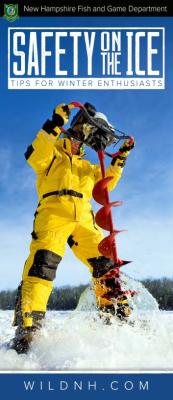Stay Safe on the Ice
Safety Tips for Frozen Water Bodies
With winter comes frozen lakes and rivers which offers up a ton of fun outdoor activities to enjoy.
Some of these activities include:
- Pond Hockey
- Ice Skating
- Cross- Country Skiing
- Snowshoeing
- Snowmobiling
- Ice Fishing
- and more
It is important to ensure your safety on unpredictable ice conditions while enjoying these outdoor opportunities.
Safety Tips:
- It is not advisable to drive vehicles onto the ice.
- If on foot, carefully assess ice safety before venturing out by using an ice chisel or auger to determine ice thickness and condition. Continue to do this as you get further out on to the ice, because the ice thickness will not be uniform all over the waterbody.
- Though all ice is potentially dangerous, the U.S. Army Cold Regions Research & Engineering Laboratory in Hanover, NH, offers a "rule of thumb" on ice thickness: There should be a minimum of six inches of hard ice before individual foot travel, and eight to ten inches of hard ice for snow machine or All-Terrain Vehicle travel.
- Remember - thick ice does not always mean safe ice! Ice can be thick, but not strong, because of varying weather conditions. Weak ice is formed when warming trends break down ice, then the slushy surface re-freezes.
- Be especially careful of areas with current, such as inlets, outlets and spring holes, where the ice can be dangerously thin.
- Stay off the ice along the shoreline if it is cracked or squishy. Don’t go on the ice during thaws.
- Watch out for thin, clear or honeycombed ice. Dark snow and ice may also indicate weak spots.
- Small bodies of water tend to freeze thicker. Rivers and lakes are more prone to wind, currents and wave action that weaken ice.
- Don’t gather in large groups or drive large vehicles onto the ice.
- If you do break through the ice, don’t panic. Move or swim back to where you fell in, where you know the ice was solid. Lay both arms on the unbroken ice and kick hard. This will help lift your body onto the ice. Carry a set of ice picks; they can help you pull yourself out if you do fall through the ice; wear them around your neck or put them in an easily accessible pocket. Once out of the water, roll away from the hole until you reach solid ice.
- Ice safety is also very important for snowmobilers. Don't assume a trail is safe just because it exists; ask about trail conditions at local snowmobile clubs or sporting goods shops before you go.

Download the
Safety on the Ice
Brochure




